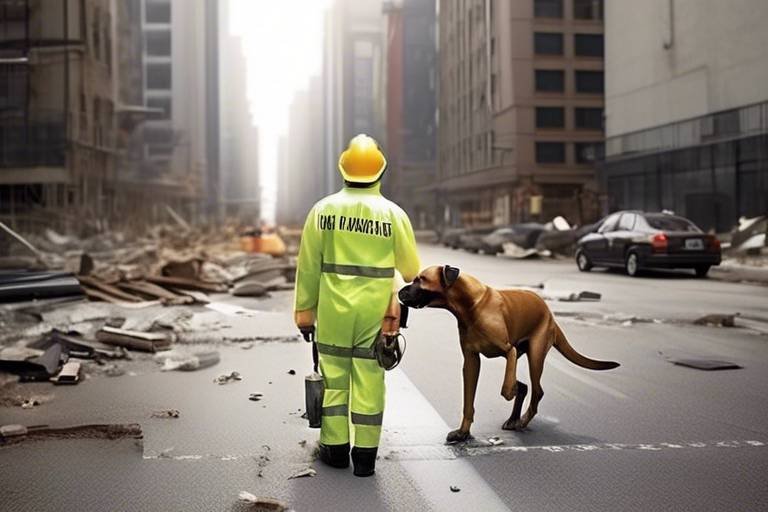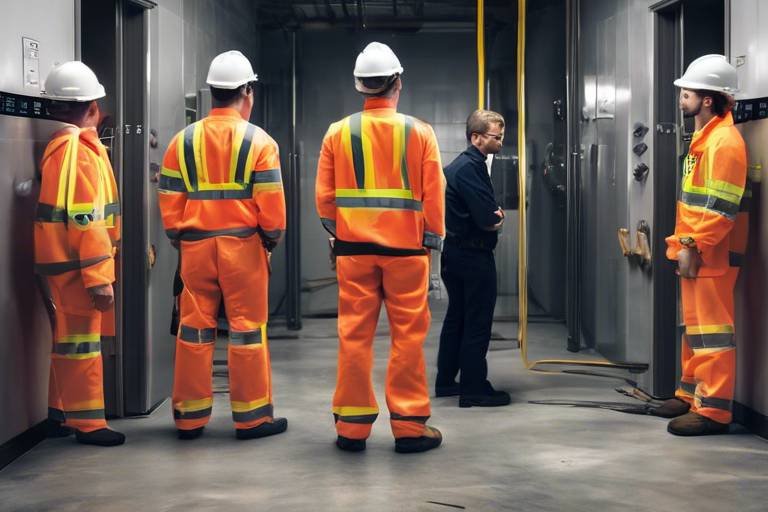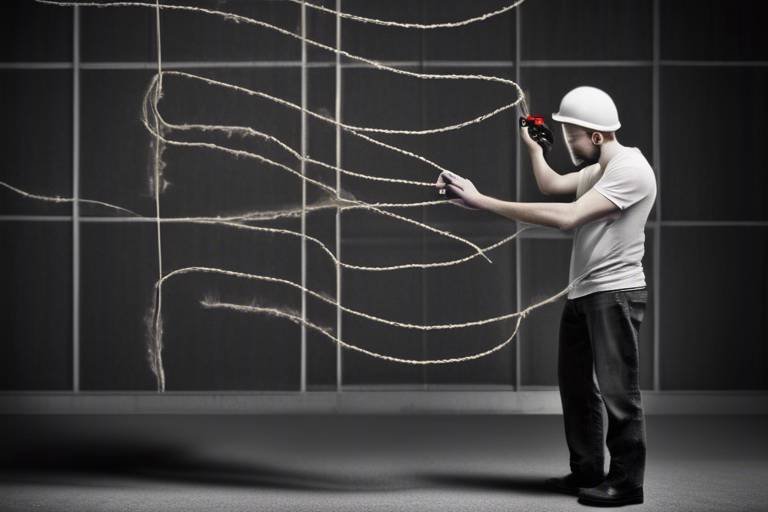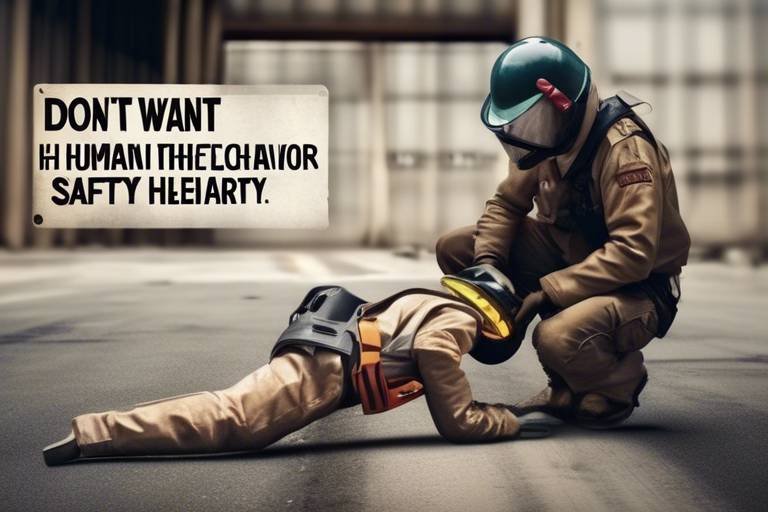Linking Safety Measures to Human Behavior
In today's world, safety is more than just a set of rules; it's a dynamic interplay between human behavior and the measures we put in place to protect ourselves. Whether in the workplace, at home, or in public spaces, the effectiveness of safety protocols often hinges on how individuals perceive and adhere to these measures. Have you ever wondered why some people consistently follow safety guidelines while others seem to ignore them? This article dives deep into the intricate relationship between safety measures and human behavior, exploring how our actions can either bolster or undermine safety strategies in various environments.
At the heart of this exploration is the recognition that safety compliance is not merely a matter of following rules; it is deeply rooted in our psychological motivations. Understanding what drives individuals to comply with safety protocols can pave the way for more effective measures. For instance, are people motivated by fear of consequences, a sense of responsibility, or perhaps a desire for social approval? Each of these factors can significantly influence how safety measures are perceived and enacted. Furthermore, identifying barriers that hinder compliance—such as lack of awareness, inadequate training, or even peer pressure—can help organizations tailor their safety strategies to address these challenges head-on.
Moreover, the role of behavioral interventions in safety training cannot be overstated. By integrating techniques that promote safe practices, organizations can foster a culture of safety that resonates with employees on a personal level. Imagine a workplace where safety is not just a checkbox on a list but an integral part of the organizational culture. This transformation can be achieved through various methods, including positive reinforcement, behavioral modeling, and effective communication. Each of these strategies plays a crucial role in shaping how individuals approach safety measures and, ultimately, how safe they feel in their environment.
In conclusion, linking safety measures to human behavior is a complex but vital endeavor. By understanding the psychological underpinnings of safety compliance and implementing effective training interventions, organizations can cultivate a robust safety culture that not only protects individuals but also enhances overall productivity and morale. The journey toward a safer environment begins with recognizing the power of human behavior in shaping our safety practices.
- What are the key factors influencing safety compliance?
Motivations such as fear of consequences, responsibility, and social approval play a significant role in influencing safety behaviors. - How can organizations improve safety training?
Incorporating behavioral interventions, such as positive reinforcement and modeling safe behaviors, can enhance training effectiveness. - What is the importance of communication in safety culture?
Open dialogue and feedback mechanisms are essential for fostering safety awareness and ensuring compliance among team members. - What challenges might arise when implementing safety measures?
Barriers such as lack of awareness, inadequate training, and ineffective communication can hinder compliance and safety culture.

The Psychology of Safety Compliance
Understanding the psychological factors that influence individuals’ adherence to safety measures is crucial for enhancing compliance and reducing risks. Why do some people follow safety protocols while others seem to disregard them entirely? The answer often lies in the complex interplay of motivations and barriers that shape our behaviors. For instance, individuals may be motivated by a desire to protect themselves or their coworkers, but they might also face barriers such as complacency, lack of awareness, or even peer pressure.
One significant factor is the perception of risk. When individuals perceive a high level of danger in their environment, they are more likely to comply with safety measures. Conversely, if they believe that the risks are minimal, they may feel less compelled to follow protocols. This is akin to driving a car: when you see a sign warning of a steep hill ahead, you instinctively slow down. However, if the road appears flat and safe, you might not think twice about speeding. This perception is often influenced by past experiences, training, and even the culture within an organization.
Additionally, social influence plays a vital role in safety compliance. Humans are inherently social creatures, and our behaviors are often shaped by those around us. If a colleague consistently ignores safety measures, it may lead others to believe that such behavior is acceptable. On the flip side, if safe practices are visibly recognized and rewarded, it can create a ripple effect, encouraging others to adopt similar behaviors. This highlights the importance of fostering a positive safety culture where safe behaviors are celebrated and reinforced.
Moreover, motivation can be broken down into intrinsic and extrinsic factors. Intrinsic motivation stems from personal values and beliefs, such as the desire to ensure one’s own safety or the safety of others. Extrinsic motivation, on the other hand, might involve rewards or recognition from the organization. Both types of motivation can be powerful, but organizations often need to cultivate a balance. For example, while monetary rewards can be effective, intrinsic motivations like personal pride and a sense of responsibility can lead to more sustainable compliance.
Barriers to compliance can be numerous and varied, ranging from a lack of training to inadequate communication about safety protocols. It’s not uncommon for employees to feel overwhelmed by the sheer volume of rules and regulations, leading to disengagement. To combat this, organizations should strive to simplify safety measures and ensure they are clearly communicated. Regular training sessions that incorporate real-life scenarios can also help reinforce the importance of compliance in a relatable way.
In conclusion, understanding the psychology behind safety compliance is essential for any organization aiming to create a safer environment. By addressing the motivations and barriers that influence behavior, organizations can enhance their safety protocols and foster a culture where compliance is not just expected but embraced. In the end, it’s about creating a shared responsibility for safety, where everyone plays a part in protecting themselves and each other.

Behavioral Interventions in Safety Training
When it comes to safety training, the traditional methods often fall short of achieving the desired results. This is where behavioral interventions come into play. These interventions focus on understanding and modifying the behaviors of individuals to enhance overall safety compliance. Imagine a workplace where employees not only understand the safety protocols but are also actively engaged in practicing them. That’s the magic of behavioral interventions!
One of the core principles of behavioral interventions is the recognition that human behavior is often influenced by environmental factors. By creating a supportive environment that encourages safe practices, organizations can significantly reduce the likelihood of accidents. For instance, consider the layout of a factory floor. If safety equipment is easily accessible and clearly marked, employees are more likely to use it. This simple change can have a profound impact on safety outcomes.
Moreover, effective safety training programs incorporate various techniques that actively engage participants. For example, role-playing scenarios can be incredibly effective in demonstrating the consequences of unsafe behaviors. By allowing employees to step into different roles, they can better understand the importance of following safety protocols. This experiential learning not only reinforces the training but also makes it memorable.
Another powerful technique is the use of visual aids. Infographics, videos, and posters can serve as constant reminders of safety practices. When employees see these visual cues regularly, they are more likely to internalize the messages. A table summarizing different types of visual aids and their effectiveness can be helpful:
| Type of Visual Aid | Effectiveness |
|---|---|
| Infographics | High - Simplifies complex information |
| Videos | High - Engages multiple senses |
| Posters | Moderate - Good for reminders but may be overlooked |
Furthermore, integrating peer-to-peer training can enhance the effectiveness of safety protocols. When employees learn from each other, it fosters a sense of camaraderie and accountability. This approach not only builds trust but also encourages individuals to adopt safe behaviors as they witness their peers doing the same. Imagine the ripple effect this can create in an organization—one person’s commitment to safety can inspire others to follow suit!
In conclusion, the incorporation of behavioral interventions in safety training programs is not just a trend; it’s a necessity. By understanding the psychology behind human behavior and utilizing various engaging techniques, organizations can foster a culture of safety that resonates with every employee. The goal is clear: to create an environment where safety is not just a protocol but a shared value.
- What are behavioral interventions? Behavioral interventions are strategies designed to modify individuals' behaviors to enhance safety compliance.
- How can role-playing improve safety training? Role-playing allows employees to understand the consequences of unsafe behaviors, making the training more impactful and memorable.
- Why are visual aids important in safety training? Visual aids serve as constant reminders and help simplify complex safety information, making it easier for employees to remember.
- What is peer-to-peer training? Peer-to-peer training involves employees teaching and learning from each other, fostering accountability and camaraderie in safety practices.

Positive Reinforcement Strategies
When it comes to ensuring safety in the workplace, can be game-changers. Imagine a scenario where employees feel appreciated for adhering to safety protocols; this not only boosts morale but also enhances compliance. The essence of positive reinforcement lies in recognizing and rewarding safe behaviors, which can lead to a more robust safety culture. So, how do we effectively implement these strategies?
One effective approach is to establish a reward system that acknowledges individuals and teams who consistently follow safety measures. This could include monetary bonuses, public recognition, or even simple thank-you notes that highlight their contributions. For instance, a monthly safety award can create a healthy competition among employees, encouraging them to prioritize safety in their daily tasks. By fostering an environment where safe behavior is celebrated, organizations can cultivate a mindset that values safety above all else.
Moreover, it’s crucial to provide immediate feedback when safe practices are observed. This can be done through informal check-ins, where supervisors can commend employees on their safe actions. Such timely recognition reinforces the desired behavior and strengthens the connection between safety compliance and positive outcomes. Think of it like watering a plant; the more you nurture it, the more it thrives. In this case, the plant is the safety culture, and your encouragement is the water it needs to grow.
However, the implementation of positive reinforcement is not without its challenges. Organizations may face hurdles such as a lack of resources or inconsistent application of reward systems. To overcome these obstacles, it’s essential to establish clear guidelines and ensure that all team members understand the criteria for receiving rewards. Transparency in the process helps to eliminate any perceptions of favoritism and promotes fairness. Additionally, regular training sessions on the importance of safety and the role of positive reinforcement can keep the focus sharp and motivate employees to engage with safety protocols actively.
In summary, the integration of positive reinforcement strategies into safety training can significantly enhance compliance and foster a culture of safety. By recognizing and rewarding safe behaviors, organizations not only improve their safety records but also create an environment where employees feel valued and motivated. Remember, safety is not just a protocol; it’s a mindset, and with the right reinforcement strategies, we can cultivate a safer workplace for everyone.
- What is positive reinforcement? Positive reinforcement is a strategy that involves rewarding desired behaviors to encourage their continuation.
- How does positive reinforcement improve safety compliance? By recognizing and rewarding safe behaviors, employees are more likely to adhere to safety protocols consistently.
- What are some examples of positive reinforcement in the workplace? Examples include bonuses, public recognition, and personal acknowledgments for individuals or teams who follow safety measures.
- What challenges might organizations face when implementing positive reinforcement? Common challenges include resource limitations, inconsistent application of rewards, and potential perceptions of favoritism.

Case Studies of Successful Reinforcement
When it comes to enhancing safety behaviors in the workplace, real-world examples can serve as powerful motivators. Companies that have successfully implemented positive reinforcement strategies often see remarkable improvements in compliance and overall safety culture. One of the standout examples is a manufacturing firm that introduced a safety rewards program. Employees were rewarded with points for following safety protocols, which could be redeemed for various incentives, such as gift cards or extra time off. The results were staggering; within just six months, the company reported a 40% reduction in workplace accidents.
Another compelling case is that of a construction company that adopted a recognition program for safe practices. They implemented a monthly "Safety Star" award, which highlighted individuals or teams who consistently adhered to safety measures. This simple yet effective strategy not only boosted morale but also fostered a sense of accountability among employees. The company saw a 30% increase in safety compliance rates and a significant drop in near-miss incidents. Such recognition made safety a shared goal rather than an individual responsibility, creating a community focused on well-being.
In the healthcare sector, a hospital introduced a similar initiative called the "Safety Champion" program. Staff members who demonstrated exceptional commitment to safety protocols were publicly acknowledged during staff meetings. This not only motivated the recognized individuals but also inspired their peers to emulate these behaviors. The hospital reported an improvement in compliance with safety protocols, leading to a 25% decrease in patient safety incidents over a year. The key takeaway? Recognizing and rewarding safe behaviors can create a ripple effect, encouraging others to follow suit.
However, it’s essential to note that while these case studies showcase success, they also highlight the importance of tailoring reinforcement strategies to fit the unique culture of each organization. What works for one company may not necessarily translate to another. Therefore, it’s crucial for organizations to assess their specific environments and employee dynamics when designing a reinforcement program.
To summarize, the case studies of successful reinforcement demonstrate that positive recognition and rewards can significantly enhance safety behaviors in various industries. By fostering an environment where safety is celebrated, organizations not only improve compliance but also cultivate a culture of care and responsibility among their workforce.
- What is positive reinforcement in safety training?
Positive reinforcement in safety training involves rewarding individuals for adhering to safety protocols, which encourages continued compliance and promotes a culture of safety. - How can organizations implement a rewards program?
Organizations can implement a rewards program by identifying key safety behaviors to reinforce, establishing a point system for rewards, and communicating the program clearly to all employees. - Are there any challenges in applying positive reinforcement?
Yes, challenges may include resistance from employees, inconsistencies in recognition, and ensuring that the rewards are meaningful to the staff. - Can positive reinforcement improve safety culture?
Absolutely! By recognizing and rewarding safe behaviors, organizations can create a more engaged workforce that prioritizes safety, leading to a stronger safety culture.

Challenges in Implementing Reinforcement
Implementing positive reinforcement in safety measures isn't always a walk in the park. While the concept sounds simple—rewarding safe behavior to encourage more of it—there are several challenges organizations face that can complicate this process. One significant hurdle is the inconsistent application of reinforcement strategies. If rewards are not consistently given, employees may feel confused or demotivated. Imagine trying to train a dog; if you only reward it sometimes for good behavior, it might not understand what you want. Similarly, if workers see that only certain individuals receive recognition for following safety protocols, it can lead to feelings of unfairness and resentment.
Another challenge is the subjectivity of rewards. What one manager considers a commendable act might not resonate with another. This inconsistency can lead to a perception that rewards are based on favoritism rather than genuine safety compliance. To tackle this, organizations should strive for clear criteria that define what constitutes safe behavior worthy of recognition. Establishing transparent guidelines can help ensure everyone is on the same page, making the reinforcement process feel more equitable.
Additionally, there's the issue of employee engagement. If workers don’t feel invested in safety protocols, they may not respond positively to reinforcement strategies. For instance, if employees perceive safety training as a mere checkbox exercise rather than a vital part of their job, they might disregard the importance of compliance altogether. To combat this, organizations should foster a culture where safety is seen as a shared responsibility. Engaging employees in the development of safety protocols can create a sense of ownership and commitment.
Moreover, measuring the effectiveness of reinforcement can be tricky. Organizations often struggle with data collection and analysis, which can hinder their ability to assess whether their reinforcement strategies are working. Without proper metrics, it’s challenging to determine if the rewards lead to improved safety behavior or if they simply create a temporary boost in compliance. Setting up a robust feedback system that tracks safety incidents and correlates them with reinforcement efforts can provide valuable insights.
Lastly, external factors can also play a role in the success of reinforcement strategies. Changes in the work environment, such as new equipment or processes, can impact safety behaviors. When these changes occur, it’s crucial to adapt reinforcement strategies accordingly. A flexible approach that allows organizations to pivot and adjust their methods in response to evolving circumstances will ultimately lead to a more effective safety culture.
In summary, while positive reinforcement can significantly enhance safety compliance, organizations must navigate various challenges to implement it effectively. By addressing inconsistencies, ensuring fairness, fostering engagement, measuring outcomes, and remaining adaptable, companies can create a more robust safety culture that benefits everyone.
- What is positive reinforcement in safety measures?
Positive reinforcement involves rewarding employees for following safety protocols to encourage continued compliance.
- Why is consistency important in reinforcement?
Inconsistency can lead to confusion and demotivation among employees, undermining the effectiveness of the reinforcement strategy.
- How can organizations measure the effectiveness of reinforcement?
Organizations can use feedback systems and track safety incidents to evaluate whether their reinforcement strategies are yielding desired results.
- What role does employee engagement play in safety compliance?
Engaged employees are more likely to take safety protocols seriously and respond positively to reinforcement efforts.

Behavioral Modeling Techniques
Behavioral modeling is not just a fancy term thrown around in safety training; it's a powerful tool that can transform the way individuals perceive and practice safety. Imagine walking into a room where everyone is wearing safety gear, following protocols, and actively engaging in safe behaviors. This environment encourages you to do the same. That's the essence of behavioral modeling—it’s about learning through observation.
When individuals see their peers adhering to safety measures, it creates a ripple effect. This phenomenon occurs because humans are naturally inclined to mimic the actions of others, especially those they respect or consider role models. For instance, if a supervisor consistently wears their safety helmet and encourages others to do so, employees are more likely to follow suit. This is not just about compliance; it's about creating a culture where safety is valued and prioritized.
To effectively implement behavioral modeling in safety training, organizations can use several strategies:
- Demonstration of Safe Practices: Regularly showcase safe behaviors through live demonstrations or videos. This visual representation can significantly influence employees' actions.
- Peer-to-Peer Learning: Encourage employees to share their experiences and practices. This not only reinforces safe behaviors but also fosters a sense of community.
- Mentorship Programs: Pairing less experienced employees with seasoned workers can provide them with a direct example of safe practices in action.
Moreover, it’s essential to create an environment where employees feel comfortable and encouraged to adopt these behaviors. This involves not just showing what to do, but also explaining why these actions matter. When individuals understand the why behind safety protocols, they are more likely to internalize these behaviors and make them a part of their daily routine.
One of the most compelling aspects of behavioral modeling is its ability to foster a sense of accountability among employees. When they see their colleagues engaging in safe practices, it creates a collective responsibility to uphold safety standards. This shared commitment can lead to a significant reduction in incidents and accidents, ultimately enhancing the overall safety culture within the organization.
In conclusion, behavioral modeling techniques are not just about teaching safety; they are about creating an environment where safety becomes a natural part of daily operations. By leveraging the power of observation and peer influence, organizations can cultivate a culture that prioritizes safety, leading to improved compliance and reduced risks.
Q: What is behavioral modeling in safety training?
A: Behavioral modeling involves demonstrating safe practices and encouraging employees to observe and replicate these behaviors to foster a culture of safety.
Q: How can organizations implement behavioral modeling?
A: Organizations can implement behavioral modeling through demonstrations, peer-to-peer learning, and mentorship programs that encourage safe practices.
Q: Why is it important to understand the 'why' behind safety measures?
A: Understanding the reasons behind safety protocols helps individuals internalize these behaviors, making them more likely to follow them consistently.
Q: Can behavioral modeling reduce workplace accidents?
A: Yes, by creating a culture of accountability and shared responsibility, behavioral modeling can lead to a significant reduction in incidents and accidents.

The Role of Communication in Safety Culture
Effective communication is the backbone of a robust safety culture. When it comes to ensuring that safety measures are understood and followed, the way information is conveyed can make all the difference. Imagine a workplace where employees feel comfortable voicing their concerns and sharing their ideas about safety protocols. This open dialogue not only fosters trust but also encourages a proactive approach to safety. After all, wouldn't you agree that a team that communicates well is more likely to spot potential hazards before they become serious issues?
In many organizations, safety is often treated as a checkbox exercise. However, when communication becomes a priority, safety transforms into a shared responsibility. Employees should not only be recipients of safety information but active participants in discussions about safety practices. This shift in mindset can lead to a more engaged workforce, where individuals feel empowered to take ownership of their safety and that of their colleagues. But how can organizations cultivate this environment?
One effective strategy is to implement regular safety meetings and training sessions that encourage dialogue. These gatherings can serve as a platform for employees to discuss safety challenges they face in their daily tasks. Additionally, utilizing various communication channels—such as emails, newsletters, and bulletin boards—ensures that safety messages reach everyone. For instance, consider the following table that outlines different communication methods and their effectiveness in promoting safety culture:
| Communication Method | Effectiveness |
|---|---|
| Safety Meetings | High - Encourages open dialogue and feedback |
| Email Updates | Medium - Provides information but lacks interaction |
| Bulletin Boards | Medium - Visible reminders, but may not engage |
| Training Sessions | High - Hands-on learning fosters understanding |
Another crucial aspect of communication in safety culture is the establishment of feedback loops. These loops allow organizations to gather input from employees about existing safety measures and identify areas for improvement. When employees see that their feedback is valued and leads to tangible changes, it reinforces their commitment to safety protocols. This cycle of feedback not only enhances safety practices but also boosts employee morale.
However, communication isn’t without its challenges. Barriers such as language differences, hierarchical structures, and even technological issues can hinder effective communication. Organizations must actively work to identify and address these barriers. For example, providing safety materials in multiple languages or employing visual aids can help ensure that everyone understands the safety protocols, regardless of their background.
In conclusion, the role of communication in fostering a safety culture cannot be overstated. By prioritizing open dialogue, implementing feedback mechanisms, and overcoming communication barriers, organizations can create an environment where safety is a collective effort. After all, when everyone is on the same page, the chances of accidents and injuries decrease significantly. So, are you ready to enhance your organization's safety culture through better communication?
- What is the importance of communication in safety culture?
Communication is vital as it fosters trust, encourages employee engagement, and ensures that safety measures are understood and followed. - How can organizations improve communication about safety?
Organizations can improve communication by holding regular safety meetings, using various communication channels, and establishing feedback loops. - What are common barriers to effective communication in safety?
Common barriers include language differences, hierarchical structures, and technological challenges. - How can feedback loops enhance safety practices?
Feedback loops allow employees to share their insights and concerns, leading to continuous improvement in safety measures.

Feedback Loops for Continuous Improvement
In any organization, creating an environment where safety measures are continuously improved is essential. This is where feedback loops come into play. Feedback loops refer to the processes that allow organizations to gather information about their safety practices, analyze that information, and implement changes based on the findings. Think of it as a cycle of learning and adaptation—much like how a gardener tends to their plants, observing what thrives and what doesn’t, and adjusting their care accordingly.
Establishing effective feedback loops involves several key components. First, it’s crucial to create a culture that encourages open communication. Employees should feel comfortable sharing their thoughts on safety protocols without fear of reprimand. This can be achieved through regular safety meetings, anonymous surveys, or even suggestion boxes. When team members feel heard, they are more likely to engage in the feedback process, leading to more valuable insights.
Once feedback is collected, the next step is to analyze it. This is where organizations can identify trends or recurring issues. For example, if multiple employees report that a specific safety protocol is confusing or ineffective, it’s a clear signal that changes may be necessary. Using data analytics tools can greatly enhance this process, allowing for a more thorough examination of safety trends over time. The goal here is not just to react to problems but to proactively identify areas for improvement.
After analyzing the feedback, organizations must take action. This is where the cycle of improvement truly begins. Changes should be communicated clearly to all employees, reinforcing the idea that their input has led to tangible outcomes. For instance, if a new safety procedure is implemented based on employee feedback, it’s important to highlight this change in company meetings or newsletters. This not only shows that the organization values employee input but also helps to foster a culture of continuous improvement.
Moreover, it’s essential to evaluate the effectiveness of the changes made. This can be done through follow-up surveys or assessments to determine if the new measures have improved safety compliance or reduced incidents. By regularly revisiting the feedback loop, organizations can ensure that their safety protocols remain relevant and effective. This ongoing process can be visualized in the following table:
| Step | Description |
|---|---|
| 1. Gather Feedback | Collect insights from employees through meetings, surveys, and suggestion boxes. |
| 2. Analyze Data | Identify trends and recurring issues using data analytics tools. |
| 3. Implement Changes | Make necessary adjustments to safety protocols based on feedback. |
| 4. Communicate Outcomes | Inform employees about changes and how their feedback influenced decisions. |
| 5. Evaluate Effectiveness | Follow up with assessments to measure the impact of changes made. |
In conclusion, feedback loops are a powerful tool for fostering continuous improvement in safety measures. By encouraging open communication, analyzing data, implementing changes, and evaluating outcomes, organizations can create a dynamic safety culture that not only protects employees but also enhances overall workplace morale. Remember, just like a well-tended garden, a thriving safety culture requires constant attention and care.
- What is a feedback loop in safety management?
A feedback loop in safety management is a systematic process of gathering, analyzing, and acting on feedback related to safety practices to drive continuous improvement. - Why is open communication important for feedback loops?
Open communication fosters trust and encourages employees to share their insights, leading to more effective safety measures and a culture of collaboration. - How can organizations ensure the effectiveness of changes made?
Organizations can ensure effectiveness by regularly evaluating the impact of changes through follow-up surveys, assessments, and ongoing feedback collection.

Barriers to Effective Communication
When it comes to safety in the workplace, effective communication is the backbone that supports a strong safety culture. However, various barriers can hinder this vital process, making it difficult for employees to understand and adhere to safety protocols. One of the primary challenges is the lack of clarity in communication. If safety messages are convoluted or filled with jargon, employees may misinterpret them, leading to unsafe practices. Imagine trying to navigate a maze blindfolded; without clear directions, it's easy to get lost. Similarly, unclear safety instructions can result in confusion and, ultimately, accidents.
Another significant barrier is cultural differences. In today's globalized workforce, teams often comprise individuals from diverse backgrounds, each with their own communication styles and interpretations of safety norms. For instance, what may be considered a straightforward instruction in one culture could be perceived as vague or even disrespectful in another. This cultural disconnect can create misunderstandings that jeopardize safety compliance. Additionally, language barriers can further complicate matters. Employees who are not fluent in the primary language used for safety communications may struggle to grasp essential safety information, resulting in increased risks.
Moreover, the hierarchical structure within organizations can also pose a challenge. Employees may feel intimidated to voice their concerns or ask questions about safety protocols, especially if they perceive a power distance between themselves and management. This fear of reprisal can lead to a culture of silence, where critical safety issues go unaddressed. To illustrate this, consider a scenario where a worker notices a potential safety hazard but hesitates to report it due to fear of being judged. The longer this issue remains unreported, the greater the risk it poses to everyone in the workplace.
In addition, the lack of feedback mechanisms can stifle effective communication. If employees do not have a way to provide input on safety measures or report issues, they may feel disengaged and less likely to comply with safety protocols. Regular feedback loops not only encourage open dialogue but also foster a sense of ownership among employees regarding their safety and the safety of their coworkers. For example, implementing anonymous reporting systems can empower workers to share their concerns without fear, leading to a more proactive approach to safety.
Lastly, the fast-paced nature of many work environments can lead to information overload. When employees are bombarded with too much information at once, they may struggle to retain critical safety messages. This can result in important protocols being overlooked or forgotten. To combat this, organizations should prioritize concise and focused communication, ensuring that safety messages are clear, relevant, and easily digestible. By breaking down complex information into manageable pieces, employees are more likely to absorb and act upon it.
Addressing these barriers to effective communication is crucial for enhancing safety compliance and creating a culture where safety is prioritized. Organizations that invest in training programs focused on improving communication skills, fostering inclusivity, and implementing robust feedback mechanisms will likely see a significant improvement in safety practices. After all, effective communication is not just about exchanging information; it's about building trust and ensuring that everyone feels empowered to contribute to a safer work environment.
- What are common barriers to effective communication in the workplace?
Common barriers include lack of clarity, cultural differences, language barriers, hierarchical structures, lack of feedback mechanisms, and information overload. - How can organizations improve communication regarding safety?
Organizations can enhance communication by simplifying safety messages, fostering an inclusive environment, encouraging feedback, and providing training on effective communication skills. - Why is feedback important in safety communication?
Feedback allows for continuous improvement and ensures that employees feel engaged and valued, leading to a stronger safety culture. - What role does culture play in safety communication?
Cultural differences can affect how safety messages are interpreted and understood, making it essential for organizations to be aware of and address these differences.
Frequently Asked Questions
- What are the key psychological factors that impact safety compliance?
Understanding psychological factors such as motivation, fear of consequences, and perceived risks can significantly influence safety compliance. When individuals feel personally invested in their safety and recognize the potential dangers, they are more likely to adhere to safety measures. It's like knowing that wearing a seatbelt could save your life; it becomes a priority.
- How can positive reinforcement improve safety behaviors?
Positive reinforcement encourages individuals to follow safety protocols by rewarding them for their compliance. This could be in the form of recognition, bonuses, or even simple praise. Think of it as training a pet; when they do something right, they get a treat, making them more likely to repeat that behavior!
- What challenges might organizations face when implementing positive reinforcement?
While positive reinforcement can be effective, organizations may encounter challenges such as inconsistency in rewards, lack of management support, or employee skepticism. It's essential to create a transparent system where everyone understands the rewards and feels motivated, much like a well-oiled machine that runs smoothly when all parts work together.
- How does behavioral modeling influence safety training?
Behavioral modeling works by allowing individuals to observe and emulate safe practices demonstrated by others. This technique can be incredibly effective because people often learn better by watching rather than just listening. It's like learning to ride a bike; seeing someone else do it first gives you the confidence to try it yourself!
- Why is communication essential for fostering a safety culture?
Effective communication is the backbone of a strong safety culture. Open dialogue encourages team members to voice concerns, share feedback, and discuss safety issues without fear. This creates an environment where everyone feels responsible for safety, similar to how a family discusses their needs openly to ensure everyone's well-being.
- What are feedback loops, and how do they improve safety measures?
Feedback loops involve regular communication about safety practices, allowing organizations to continuously refine and improve their safety measures. This ongoing dialogue helps identify issues early and fosters a culture of engagement, much like a gardener who regularly checks on their plants to ensure they are healthy and thriving.
- What common barriers exist to effective communication in safety contexts?
Barriers to effective communication can include hierarchical structures, lack of trust, or simply poor communication skills. Overcoming these challenges requires proactive strategies, such as training sessions and open forums, to ensure everyone feels heard and valued, just like tuning an instrument to ensure it plays harmoniously.



















